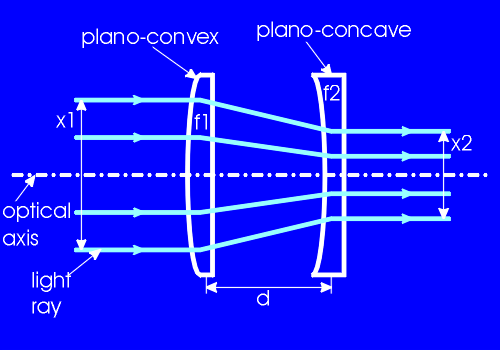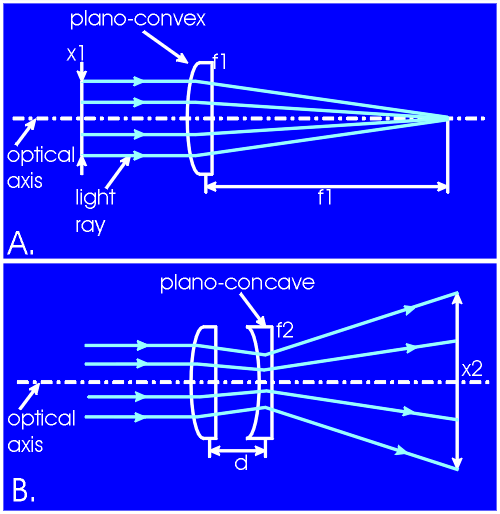Thin lens calculations
One of the primary diagnostics for shock tube experiments is imaging.
This is accomplished via one of two mechanisms, the first being through
the field imaging (e.g. Schlieren, shadowgraphy), and the second being
planar imaging using a laser sheet. Thus, it is necessary to either change the
diameter of a collimated light source, or to convert a collimated laser
beam into a wide, but very thin, laser sheet.
To begin design, it may be helpful to use the following graphical
applet. The arbitrary cooridinates in the applet may be scaled appropriately to the
desired geometry of the imaging application. The design of a two lens combination
may then be finalized with the javascript
calculations below the applet. These tools will enable the designer to
choose the appropriate lenses and provide guidance on the approximate
(due to the thin lens approximation) spacing between the lenses.
To obtain and read about this applet visit:
http://webphysics.davidson.edu/Applets/DownLoad_Files/download.html
Changing the diameter of a collimated beam
 The figure to the right shows a beam of initial diameter x1 being shrunk
to a final diameter of x2 and the distance between the two lenses is d.
If it were desired to expand the beam, the plano-concave (negative focal
length) lens would be placed first and have focal length f1, and the
plano-convex lens would be placed second and have focal length f2.
The figure to the right shows a beam of initial diameter x1 being shrunk
to a final diameter of x2 and the distance between the two lenses is d.
If it were desired to expand the beam, the plano-concave (negative focal
length) lens would be placed first and have focal length f1, and the
plano-convex lens would be placed second and have focal length f2.
To use a script for EES
Creating a laser sheet from a collimated beam
 Figure A to the right shows a beam of initial diameter x1 being
focused to a point, which is a distance f1 (the focal length of the
lens) away from lens 1. Figure B adds a negative cylindrical lens that
expands the laser beam in one dimension to form a light sheet. The
lenses are separated by a distance d and the width of the laser sheet at
the distance f1 from the first lens is x2.
Figure A to the right shows a beam of initial diameter x1 being
focused to a point, which is a distance f1 (the focal length of the
lens) away from lens 1. Figure B adds a negative cylindrical lens that
expands the laser beam in one dimension to form a light sheet. The
lenses are separated by a distance d and the width of the laser sheet at
the distance f1 from the first lens is x2.
To use a script for EES
Return to the WiSTL homepage
For questions or comments
contact Jason Oakley: oakleyj@cae.wisc.edu
 The figure to the right shows a beam of initial diameter x1 being shrunk
to a final diameter of x2 and the distance between the two lenses is d.
If it were desired to expand the beam, the plano-concave (negative focal
length) lens would be placed first and have focal length f1, and the
plano-convex lens would be placed second and have focal length f2.
The figure to the right shows a beam of initial diameter x1 being shrunk
to a final diameter of x2 and the distance between the two lenses is d.
If it were desired to expand the beam, the plano-concave (negative focal
length) lens would be placed first and have focal length f1, and the
plano-convex lens would be placed second and have focal length f2.
 Figure A to the right shows a beam of initial diameter x1 being
focused to a point, which is a distance f1 (the focal length of the
lens) away from lens 1. Figure B adds a negative cylindrical lens that
expands the laser beam in one dimension to form a light sheet. The
lenses are separated by a distance d and the width of the laser sheet at
the distance f1 from the first lens is x2.
Figure A to the right shows a beam of initial diameter x1 being
focused to a point, which is a distance f1 (the focal length of the
lens) away from lens 1. Figure B adds a negative cylindrical lens that
expands the laser beam in one dimension to form a light sheet. The
lenses are separated by a distance d and the width of the laser sheet at
the distance f1 from the first lens is x2.